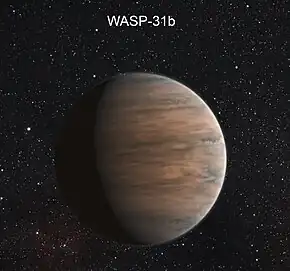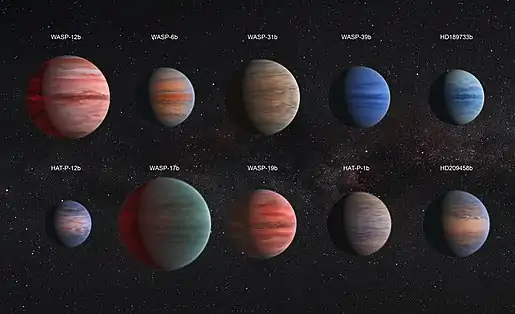 "Hot Jupiter" exoplanet WASP-31b (artist concept) | |
| Discovery | |
|---|---|
| Discovered by | Anderson, D.R. et al.[1] |
| Discovery site | WASP[2] |
| Discovery date | 2010[2] |
| Primary transit[2] | |
| Orbital characteristics | |
| 0.04657±0.00034 AU | |
| Eccentricity | 0[2] |
| 3.40591[2] d | |
| Inclination | 84.54±0.027[2] |
| Star | WASP-31[2] |
| Physical characteristics | |
Mean radius | 1.537±0.06[2] RJ |
| Mass | 0.478±0.03[2] MJ |
WASP-31b is a low-density (puffy) "hot Jupiter" extrasolar planet orbiting the metal-poor (63% of solar metallicity) dwarf star WASP-31.[1] The exoplanet was discovered in 2010 by the WASP project.[2][1] WASP-31b is in the constellation of Crater,[3] and is about 1305 light-years[4] (light travel distance) from Earth.[2]
Characteristics
WASP-31b is a low-density (puffy) "hot Jupiter" exoplanet with a mass about 0.48 times that of Jupiter and a radius about 1.55 times that of Jupiter.[2][1] The planetary atmosphere has indeed the largest scale height, equal to 1150km, among exoplanets with measurable atmospheres as at 2021.[5]
The exoplanet orbits WASP-31, its host star, every 3.4 days.[2]

(top row; 3rd from left) (artist concept)
From top left to lower right: WASP-12b, WASP-6b, WASP-31b, WASP-39b, HD 189733b, HAT-P-12b, WASP-17b, WASP-19b, HAT-P-1b and HD 209458b.
In 2012, it was found from the Rossiter–McLaughlin effect that WASP-31b is orbiting the parent star in a prograde direction, with the WASP-31 star rotational axis inclined to the planetary orbit by 2.8±3.1 degrees.[6] The spectroscopic study in 2014 revealed that WASP-31b has a dense cloud deck overlaid by a hazy atmosphere.[7] WASP-31b was also reported to have significant amounts of potassium in its upper atmosphere, but the detection of potassium was refuted in 2015.[8] The potassium detection discrepancy was resolved in 2020 with the improved cloud deck model,[9] with the best fit being a very small amount of water over clouds and no potassium at all.[10]
Reanalysis of planetary spectroscopic data in 2020 has revealed the presence of chromium monohydride besides water.[11]
See also
References
- 1 2 3 4 Anderson, D.R.; et al. (2011). "WASP-31b: a low-density planet transiting a metal-poor, late-F-type dwarf star" (PDF). Astronomy & Astrophysics. 531: A60. arXiv:1011.5882. Bibcode:2011A&A...531A..60A. doi:10.1051/0004-6361/201016208. S2CID 20154835.
- 1 2 3 4 5 6 7 8 9 10 11 12 13 Staff (2018). "Planet WASP-31 b". Extrasolar Planets Encyclopaedia. Retrieved 2 March 2018.
- ↑ DJM (2018). "Finding the constellation which contains given sky coordinates". djm.cc. Retrieved 2 March 2018.
- ↑ Kyle (2018). "Convert Parsecs to Light Years". KylesConverter.com. Retrieved 2 March 2018.
- ↑ Baxter, Claire; Désert, Jean-Michel; Tsai, Shang-Min; Todorov, Kamen O.; Bean, Jacob L.; Deming, Drake; Parmentier, Vivien; Fortney, Jonathan J.; Line, Michael; Thorngren, Daniel; Pierrehumbert, Raymond T.; Burrows, Adam; Showman, Adam P. (2021), "Evidence for disequilibrium chemistry from vertical mixing in hot Jupiter atmospheres", Astronomy & Astrophysics, 648: A127, arXiv:2103.07185, doi:10.1051/0004-6361/202039708, S2CID 232222174
- ↑ Brown, D. J. A.; Cameron, A. Collier; Anderson, D. R.; Enoch, B.; Hellier, C.; Maxted, P. F. L.; Miller, G. R. M.; Pollacco, D.; Queloz, D.; Simpson, E.; Smalley, B.; Triaud, A. H. M. J.; Boisse, I.; Bouchy, F.; Gillon, M.; Hébrard, G. (2012). "Rossiter-Mc Laughlin effect measurements for WASP-16, WASP-25 and WASP-31★". Monthly Notices of the Royal Astronomical Society. 423 (2): 1503–1520. arXiv:1203.4971. Bibcode:2012MNRAS.423.1503B. doi:10.1111/j.1365-2966.2012.20973.x. S2CID 53445367.
- ↑ The atmosphere of hot-Jupiter exoplanet WASP-31b
- ↑ Gibson, Neale P.; De Mooij, Ernst J W.; Evans, Thomas M.; Merritt, Stephanie; Nikolov, Nikolay; Sing, David K.; Watson, Chris (2019). "Revisiting the potassium feature of WASP-31b at high resolution". Monthly Notices of the Royal Astronomical Society. 482 (1): 606–615. arXiv:1810.03693. Bibcode:2019MNRAS.482..606G. doi:10.1093/mnras/sty2722.
- ↑ J. Chouqar, M. L. Morales, A. Daassou, A. Jabiri, Z. Benkhaldoun, Bruce G. Elmegreen, L. Viktor Tóth, Manuel Güdel, "Modeling the Transmission Spectra of WASP-31b"
- ↑ McGruder, Chima D.; López-Morales, Mercedes; Espinoza, Néstor; Rackham, Benjamin V.; Apai, Dániel; Jordán, Andrés; Osip, David J.; Alam, Munazza K.; Bixel, Alex; Fortney, Jonathan J.; Henry, Gregory W.; Kirk, James; Lewis, Nikole K.; Rodler, Florian; Weaver, Ian C. (2020), "ACCESS: Confirmation of No Potassium in the Atmosphere of WASP-31b", The Astronomical Journal, 160 (5): 230, arXiv:2009.08472, Bibcode:2020AJ....160..230M, doi:10.3847/1538-3881/abb806, S2CID 221802525
- ↑ Braam, Marrick; Van Der Tak, Floris F. S.; Chubb, Katy L.; Min, Michiel (2021), "Evidence for chromium hydride in the atmosphere of hot Jupiter WASP-31b", Astronomy & Astrophysics, 646: A17, arXiv:2011.10558, Bibcode:2021A&A...646A..17B, doi:10.1051/0004-6361/202039509, S2CID 227118876
External links
![]() Media related to WASP-31b at Wikimedia Commons
Media related to WASP-31b at Wikimedia Commons